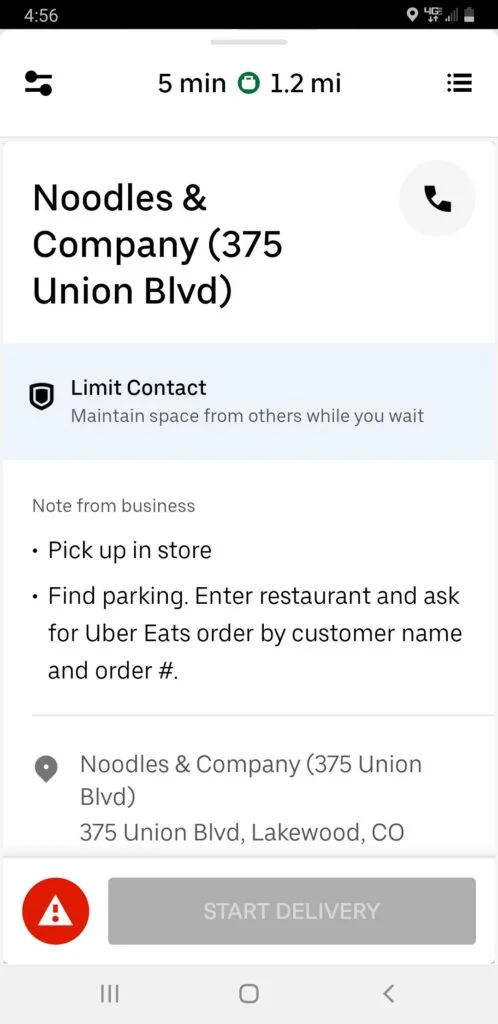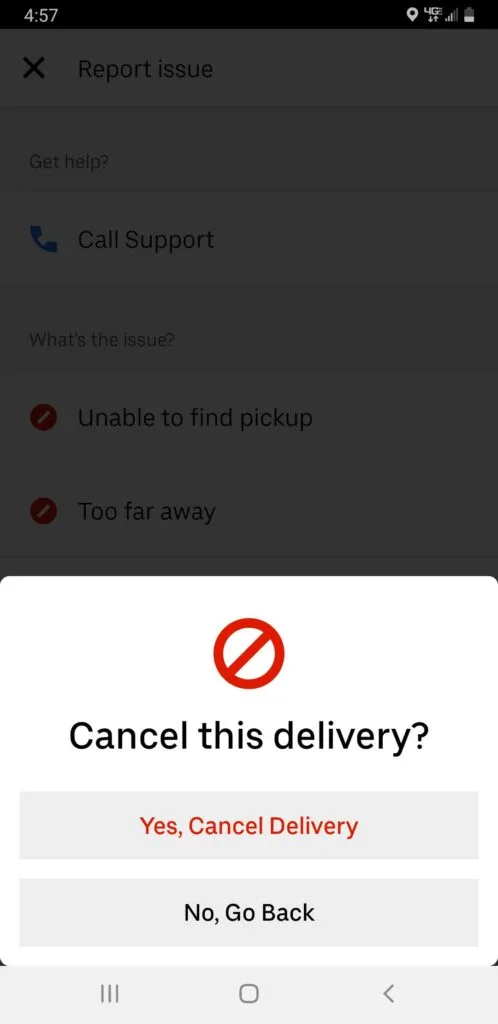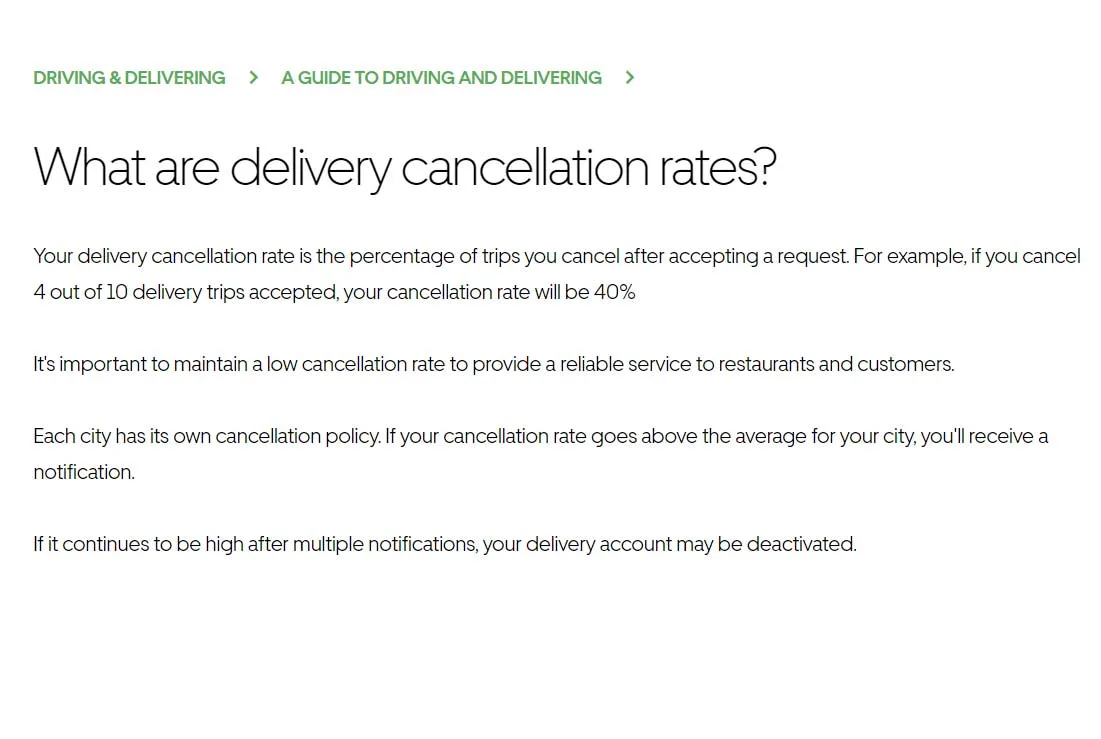Do you need to maintain a high acceptance rate when delivering for Uber Eats? What happens if you decline too many delivery offers on the Ubereats driver app?
With as much as we hear about delivery drivers having their contracts deactivated by companies like Uber Eats, that’s a question that can make you nervous. We know that acceptance rate shouldn’t matter. How do we know for sure?
Does acceptance rate matter? No. Uber Eats doesn’t even publish the acceptance rate on the driver app any more. We’ll look at that some more.
We’ll look a bit more in depth into acceptance rates for Uber Eats. In this article, we’ll examine:
- What are delivery acceptance rates on Uber Eats?
- How do we know acceptance rate doesn’t matter?
- What happens if I decline a delivery request on Uber Eats?
- Can I cancel if I accept a delivery offer on Uber Eats?
- Does completion rate matter on Uber Eats?
- How should I decide how often to accept or reject deliveries on Ubereats?

What are delivery acceptance rates on Uber Eats?
Your acceptance rate is the percentage of delivery offers you accept on the Uber app compared to the number of pings or delivery offers you receive.
While Uber Eats doesn’t show the acceptance rate any longer, it’s fair to assume they still keep track of it. If so, it’s calculated as Accepted deliveries divided by order requests sent to you. If you accepted 70 out of the last 100 offers, your acceptance rate is 70%.
I have yet to find anything that says exactly how Uber Eats defines their acceptance rate. By comparison, Doordash is very clear that their acceptance rate for Doordash drivers is based on the last 100 delivery offers.
When I started in 2018, Uber Eats did display acceptance and completion rates. But even then I never knew if that was calculated for the last 100 deliveries, a percentage of the last week, or last month, or all time or what.
The closest thing that I could find anywhere was this article from 2015 in Business Insider that shows that Uber was calculating acceptance rate on a week by week basis. While that was based on rideshare for Uber rides and it was awhile ago, it’s a little bit of a clue.

Share this Image On Your Site
Click on the text box below to copy the code. Please include attribution to EntreCourier.comFortunately, it really doesn’t seem to matter how they calculate it. According to Uber Eats, acceptance rate doesn’t matter.
How do we know acceptance rate doesn’t matter?
Uber tells us.
Your acceptance rate is no longer displayed in the Uber app. While it is important to accept trips when you are able, we no longer display your acceptance rate because it does not have an affect on your ability to earn promotions.
Uber Help page – Driving and Delivering – What are acceptance rates?
I will tell you that I’ve had some incredibly low acceptance rates on Uber Eats and it has never been an issue. This is especially true on my bike account (Uber requires me to have a different Uber account for bicycle delivery than for car delivery). Uber dispatching for bike deliveries is terrible, often far too many miles away, so I reject a LOT of offers, and it has never been an issue.
The bottom line is that you are an independent contractor. Uber has contracted with you to perform delivery services as a business, not as an employee. What that means is that legally, they cannot require you to accept specific delivery offers or even a specific number of deliveries.
Of course, they like to play the guilt card. Notice the “While it’s important to accept trips when you are able” in the quote above?
In my contract, it states “you acknowledge that your repeated failure to accept User requests for Delivery Services while you are logged in to the Provider App creates a negative user experience for Users of Uber’s technology platform. If you do not wish to accept User requests for Delivery Services for a period of time, you agree that you will log off of the Provider App.”
While all of that encourages you to accept a lot of offers, Uber does not and cannot require you to do so.
Update: As of late 2021, Uber Eats has been testing a new tactic that IS related to acceptance rate. Uber Eats has told some drivers in a select few markets that they will no longer provide up-front delivery information if drivers have rejected more than five of their last ten offers. At this time it is only a test. You can read more in the linked article.
What happens if I decline a delivery request on Uber Eats?
Nothing. Your app goes back to an idle or waiting state. There is no negative consequence to declining a delivery request.
Can I cancel if I accept a delivery offer on Uber Eats?
One thing I’ve learned is that it’s extremely easy to accidentally accept delivery offers on the Uber driver app.
With the way that the delivery app pops up when you receive an offer, especially on Android phones, it’s very easy to have the offer pop up on you while you are doing something else on your phone. It’s a lot like those websites where you go to tap the next button, but then the screen shifts and you’ve now clicked on an ad.
This is by design in both cases.
The size of the acceptance field is also extremely large, taking up at least half of your screen. This makes it easy to accidentally hit the accept when you are picking up your phone.
There may be issues with a particular delivery, such as excessive wait time, where you may decide it makes sense to cancel out on a delivery. Uber Eats makes allowances for these instances:
You retain the option… when necessary or appropriate to do so in the exercise of your business judgment, to cancel an accepted request for Delivery Services via the Provider App, subject to Company’s then-current cancellation policies
Uber Eats agreement as it read when I signed in February, 2018.
How to cancel an Uber Eats delivery that you accidentally accepted
The process for cancelling an order is probably the most hidden of all the major delivery apps, in my opinion. But once you figure it out, it’s not that difficult.
Once you accept, the order screen is going to display a map with restaurant details below. Swipe up from that restaurant information to reveal the following screen:

You’ll notice the red circle with the white triangle next to the Start Delivery button. Tap that to get the following screen:

Here you see Uber Eats’s Report Issue screen. You can choose to call support by tapping the top button, or you can choose one of the other options below. Which ever option you choose (other than contact support) will lead you to the option to cancel the order, as seen below:

From here it’s pretty self explanatory.
Important warnings about cancelling an Uber Eats order.
There are two instances where I would warn you NOT to cancel a delivery offer on Uber Eats.
- After you have picked up the food
- If the restaurant tells you that someone else picked up the food
Both situations are potential landmines for independent contractors.
After you have marked that you have picked up the food.
Once you have marked on the app that you have the food in hand, you want to do everything in your power to make sure it gets delivered. If for some reason you cannot complete the delivery once that’s happened, there’s a high probability Uber Eats will mark that against you.
I ran into this issue a number of times when Uber was not letting us know where deliveries were going. This too happened often on bike deliveries. I would pick up an order and find out the customer was 8 miles away. I would call support, report that I cannot take the delivery because of the distance, never actually pick up the food from the local restaurant, and still get a warning that I had a delivery that I picked up and never completed.
I’m a little amazed my bike account was never deactivated.
When someone else has picked the food up.
The other landmine is when the food was supposedly picked up. It’s real tempting to save time and just cancel the delivery in the app and move on. This is a bad idea.
Here’s why it’s dangerous. If you don’t contact support about this and just cancel, Uber will just send this delivery to another driver. That driver arrives, gets the same story, and they call support. So now Uber knows the food was picked up, and they see you were there before. Guess who they think took the food?
I’ve heard of drivers being deactivated for this.
The problem is, drives stealing food is a thing. They are quick to deactivate drivers they think have done this. Unfortunately, there’s a lot of incompetence in how Uber will manage individual deliveries. When everything is managed by computers and overseas call center employees, Uber won’t always have the right picture.
Which is why it’s best for you to exercise caution when it comes to cancelling a delivery order you already accepted.
Does completion rate matter on Uber Eats?
Yes.
Unfortunately, we don’t know exactly WHAT that means. Uber Eats doesn’t tell us what they consider to be low ratings.
In fact, they muddy the waters here by having two different terms for the same thing. Notice the screenshots from two different help articles:

So it’s completion rate that matters. Right?

Okay, so which one is it? On one hand they talk about completion rate, the other is cancellation rate. As far as I can tell it’s all tracking the same thing, but differently. A 70% completion rate would be a 30% cancellation rate.
Wouldn’t it?
Or is there something else different about the two?
We don’t know.
It’s important to maintain a low cancellation rate to provide a reliable service to restaurants and customers. Each city has its own cancellation policy. If your cancellation rate goes above the average for your city, you’ll receive a notification. If it continues to be high after multiple notifications, your delivery account may be deactivated.
Uber Eats delivery cancellation rate help article.
There are some transparency problems here.
First, Uber Eats no longer tells you your completion rate. You don’t know where you stand. A low ratings system that penalizes you for things you don’t know doesn’t seem reasonable to me.
Second, Uber Eats doesn’t publish the average rating for your city. Uber speaks often about the policies for your city, but they don’t give you specifics.
So unlike Doordash, who is very transparent about their completion rate policy for Dashers, Uber Eats doesn’t tell you what cancellation or completion rate will get you deactivated, nor do they let you know what your rate is. But you can still be deactivated for cancelling orders.
In other words, you’re kind of rolling the dice.
How do you avoid cancellation rate issues if Uber Eats doesn’t let you know where you are?
I do think this is a problem that Uber Eats should fix. If they hold you accountable to a rating system such as cancellation rates, they should let you know where you stand on that system.
This is where I see a big difference between them and other food delivery apps. Personally, overall I prefer Uber Eats over Doordash. However, Uber could take a page from how that food delivery service does things. Doordash is very clear what the standard is and the Doordash app displays current completion rates.
It would help if you had some idea of what a good rating is. Even knowing your acceptance rate requirement doesn’t help if they don’t tell you your rate. You’d still have to manually count every new order you accept and divide it by every new trip request you receive. That’s not very practical.
When it’s all said and done, the important thing we have to remember here is, Uber Eats doesn’t do that. Fair or not, this is the part of the deal now delivering for Uber. We can’t control that, but we can control what we do.
A good practice is to try to complete at least 90% of your offers. I don’t think you need to actually count, but once you accept an offer, it’s best to do everything you can to make sure you follow through.
Avoid orders that are likely to be canceled.
A great way to avoid cancellations is to pay attention to different reasons you might cancel, and try to avoid those situations. For me personally, there are two scenarios where cancelling is a big deal. I focus on how I can reduce cancellations on those two.
When the restaurant doesn’t have the food ready and there’s an extreme wait time.
As you deliver more and more, you get to know the restaurants that are most likely to have a long wait time. You start to learn other situations that may be a problem. Pay attention, and don’t accept those delivery offers to begin with.
The best way to keep your completion rate in a good place is to be very careful about which delivery offers you accept.
When I’ve accidentally accepted an offer
As mentioned above, this happens very easily. An important factor is thatdelivery information goes away once you accept an offer. You have no clue what you just accepted. For this reason, it’s almost always an immediate cancellation for me.
Uber Eats makes it too easy for this to happen, and bike deliveries are the biggest culprit for me. Because I never trusted bike phone holders, I often kept my phone in my pocket. That led to a lot ofpocket acceptances. I can’t tell you how many times I pulled my phone out and realized, “oh, crap, I’m on a delivery!”
Because of not knowing how far I’m going, and the probability being too much Uber just gave me a long distance delivery, I’ll always cancel an accidental acceptance while on my bike. Always.
I’m a little amazed I was never deactivated.
However, I did find an extremely secure phone holder for my bike by Quadlock. That link is an affiliate link from Amazon. It is a bit more expensive and requires a special case, however it’s I felt it’s cheaper to overpay for a good phone holder than to fix or replace my phone.
Ultimately, that’s your best defense against accidental acceptance: Be very careful about what you are doing with your phone when available on Uber Eats. Keep the phone in your phone holder and avoid doing anything else on the app when there’s a chance an order could pop up.
One of the best practices to this is to disable “always on top” permission after going available on the app (you can’t go available with it disabled). This prevents the acceptance screen from popping up while you’re using another app. It’s a pain and an extra step but can be a good way to avoid this issue.
How should I decide how often to accept or reject deliveries on Ubereats?
There’s something I like about the wording in the one quote above from my Uber Eats contract:
“in the exercise of your business judgment.”
There is no Ubereat’s deactivation policy for a minimum acceptance rate. They don’t even publish your acceptance rate. While they’d love for you to accept a lot of trip requests they cannot force you to.
Ultimately, our agreement with Uber Eats is a delivery by delivery agreement. There is no requirement to accept a delivery, but once you accept your agreement goes into affect.
For me, that means I’m very careful about what I accept. The good news is, Uber Eats provides a lot of details on their offer screen, and that helps make good business decisions.
I don’t worry about acceptance rate. All I worry about is whether the combination of delivery turnaround times and pay make it a profitable offer. Will it take a long time for what it pays? I use a 50 cent rule – I have to think that a delivery will pay 50 cents a minute or more.
Obviously you need to make your own decisions. Each of us has the right as a business owner to determine what in your “business judgment” is a good delivery.
The last thing I’ll say on this is, I think a lower acceptance rate can be safer. That’s because Uber Eats does crack down on cancellations and does not crack down on acceptance rate. It’s better to turn down new orders that may lead to cancellation.
Make good business decisions. Uber Eats will send a lot of requests to you. You don’t have to accept them. However, you can choose the ones that are profitable for you.
Related: Is Uber Eats a good job?


